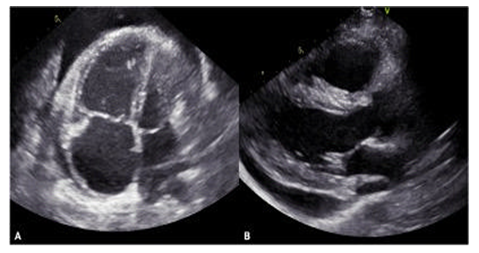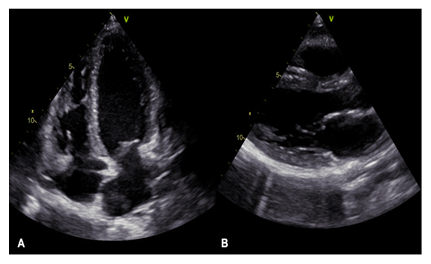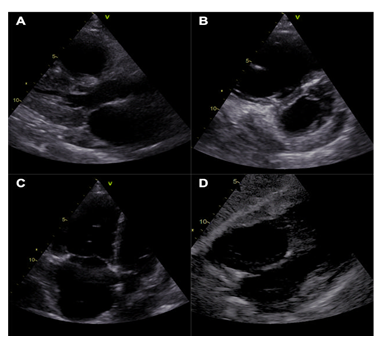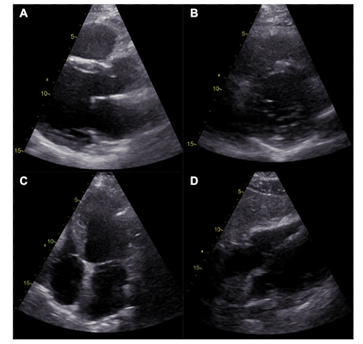Interferon-Beta and Pulmonary Artery Hypertension: Case Reports and Review of the Literature
Article Information
Lanzillo G1,2, Scelsi L1, Bergamaschi R3, Greco G3,4, Breviario F1,2, Turco A1, Greco A1, Oltrona Visconti L1, Ghio S1
1Division of Cardiology, IRCCS Policlinico San Matteo, Pavia, Italy
2Department of Molecular Medicine, University of Pavia, Pavia, Italy
3Multiple Sclerosis Centre, IRCCS Mondino Foundation, Pavia, Italy
4Department of Brain and Behavioral Sciences, University of Pavia, Pavia, Italy
*Corresponding Author: Stefano Ghiode, Division of Cardiology, IRCCS Policlinico San Matteo, Pavia, Italy.
Received: 20 December 2021; Accepted: 04 January 2022; Published: 20 May 2022
Citation: Lanzillo G, Scelsi L, Bergamaschi R, Greco G, Breviario F, Turco A, Greco A, Oltrona Visconti L, Ghio S. Interferon-Beta and Pulmonary Artery Hypertension: Case Reports and Review of the Literature. Archives of Clinical and Medical Case Reports 6 (2022): 388-397.
View / Download Pdf Share at FacebookKeywords
Hypertention; dyspnea; Pain; Pruritus
Hypertention articles; dyspnea articles; Pain articles; Pruritus articles
Hypertention articles Hypertention Research articles Hypertention review articles Hypertention PubMed articles Hypertention PubMed Central articles Hypertention 2023 articles Hypertention 2024 articles Hypertention Scopus articles Hypertention impact factor journals Hypertention Scopus journals Hypertention PubMed journals Hypertention medical journals Hypertention free journals Hypertention best journals Hypertention top journals Hypertention free medical journals Hypertention famous journals Hypertention Google Scholar indexed journals dyspnea articles dyspnea Research articles dyspnea review articles dyspnea PubMed articles dyspnea PubMed Central articles dyspnea 2023 articles dyspnea 2024 articles dyspnea Scopus articles dyspnea impact factor journals dyspnea Scopus journals dyspnea PubMed journals dyspnea medical journals dyspnea free journals dyspnea best journals dyspnea top journals dyspnea free medical journals dyspnea famous journals dyspnea Google Scholar indexed journals Pruritus articles Pruritus Research articles Pruritus review articles Pruritus PubMed articles Pruritus PubMed Central articles Pruritus 2023 articles Pruritus 2024 articles Pruritus Scopus articles Pruritus impact factor journals Pruritus Scopus journals Pruritus PubMed journals Pruritus medical journals Pruritus free journals Pruritus best journals Pruritus top journals Pruritus free medical journals Pruritus famous journals Pruritus Google Scholar indexed journals Neoplasms articles Neoplasms Research articles Neoplasms review articles Neoplasms PubMed articles Neoplasms PubMed Central articles Neoplasms 2023 articles Neoplasms 2024 articles Neoplasms Scopus articles Neoplasms impact factor journals Neoplasms Scopus journals Neoplasms PubMed journals Neoplasms medical journals Neoplasms free journals Neoplasms best journals Neoplasms top journals Neoplasms free medical journals Neoplasms famous journals Neoplasms Google Scholar indexed journals odontogenic epithelium articles odontogenic epithelium Research articles odontogenic epithelium review articles odontogenic epithelium PubMed articles odontogenic epithelium PubMed Central articles odontogenic epithelium 2023 articles odontogenic epithelium 2024 articles odontogenic epithelium Scopus articles odontogenic epithelium impact factor journals odontogenic epithelium Scopus journals odontogenic epithelium PubMed journals odontogenic epithelium medical journals odontogenic epithelium free journals odontogenic epithelium best journals odontogenic epithelium top journals odontogenic epithelium free medical journals odontogenic epithelium famous journals odontogenic epithelium Google Scholar indexed journals treatment articles treatment Research articles treatment review articles treatment PubMed articles treatment PubMed Central articles treatment 2023 articles treatment 2024 articles treatment Scopus articles treatment impact factor journals treatment Scopus journals treatment PubMed journals treatment medical journals treatment free journals treatment best journals treatment top journals treatment free medical journals treatment famous journals treatment Google Scholar indexed journals CT articles CT Research articles CT review articles CT PubMed articles CT PubMed Central articles CT 2023 articles CT 2024 articles CT Scopus articles CT impact factor journals CT Scopus journals CT PubMed journals CT medical journals CT free journals CT best journals CT top journals CT free medical journals CT famous journals CT Google Scholar indexed journals surgery articles surgery Research articles surgery review articles surgery PubMed articles surgery PubMed Central articles surgery 2023 articles surgery 2024 articles surgery Scopus articles surgery impact factor journals surgery Scopus journals surgery PubMed journals surgery medical journals surgery free journals surgery best journals surgery top journals surgery free medical journals surgery famous journals surgery Google Scholar indexed journals Pathogenesis articles Pathogenesis Research articles Pathogenesis review articles Pathogenesis PubMed articles Pathogenesis PubMed Central articles Pathogenesis 2023 articles Pathogenesis 2024 articles Pathogenesis Scopus articles Pathogenesis impact factor journals Pathogenesis Scopus journals Pathogenesis PubMed journals Pathogenesis medical journals Pathogenesis free journals Pathogenesis best journals Pathogenesis top journals Pathogenesis free medical journals Pathogenesis famous journals Pathogenesis Google Scholar indexed journals Pulmonary Artery articles Pulmonary Artery Research articles Pulmonary Artery review articles Pulmonary Artery PubMed articles Pulmonary Artery PubMed Central articles Pulmonary Artery 2023 articles Pulmonary Artery 2024 articles Pulmonary Artery Scopus articles Pulmonary Artery impact factor journals Pulmonary Artery Scopus journals Pulmonary Artery PubMed journals Pulmonary Artery medical journals Pulmonary Artery free journals Pulmonary Artery best journals Pulmonary Artery top journals Pulmonary Artery free medical journals Pulmonary Artery famous journals Pulmonary Artery Google Scholar indexed journals
Article Details
Introduction
Interferon Beta (IFNb) was the first developed drug for Multiple Sclerosis (MS) treatment. Its discovery and introduction to clinical practice, revolutionized the landscape of a disease that was thought to be incurable, being the driver of a paradigm shift in MS, from symptomatic management into disease modifying long-term therapy, with a tangible change in prognosis. Although newer, more effective and easier to manage drugs are now available, IFNb is still widely used as a first line treatment for MS, mostly because its safety and tolerability has been well known for many years. Common side effects include injection site reactions (erythema, pain, pruritus) and flu-like symptoms such as malaise, fever, headache, myalgia, chills; those are generally reported as mild or moderate at worst, although they often hinder treatment compliance [1-4].
A rare, albeit extremely severe complication of IFN treatment is Pulmonary Arterial Hypertension (PAH), historically defined as mean pulmonary arterial pressure (mPAP) ≥25 mmHg at rest, measured by right heart catheterization (RHC) [5]. Among the clinical classification of PAH, a specific category is reserved for drug- and toxin-induced PAH, which is subdivided in two groups: definite association to PAH, with data based mostly on large multicentre studies, and possible association to PAH, where correlation has been described in multiple case series. The latter category includes IFNb.
1. Case Report 1
We report the case of a 31-year-old woman, who was diagnosed with Multiple Sclerosis (MS) in 2014. She was started on IFNb. Disease course was mild since then, with no evidence of disease activity, both clinically and radiologically, and very good tolerance of the drug. In early 2021, she developed progressive dyspnoea on exertion, weakness, and fatigue. She was then admitted to the Cardiology Department, where a transthoracic echocardiogram (TTE) showed pericardial effusion, hypertrophic and dilated right ventricle (RV) with mild systolic disfunction (Tricuspid annular plane systolic excursion [TAPSE] 13 mm, Fractional Area Change [FAC] 30%), and severe pulmonary hypertension (Figure 1A).

Figure 1A: First clinical case: patient’s baseline echocardiographic findings. Panel A: apical four-chamber view. Panel B: parasternal long axis view. TTE shows pericardial effusion, hypertrophic and dilated right ventricle.
The ECG showed sinus tachycardia with right bundle branch block (RBBB). Pulmonary CT was negative for parenchymal alterations, including fibrosis or signs of pulmonary thromboembolism. Blood work was unremarkable, and ultrasound scans ruled out other causes of right heart congestion, including liver disorders. RHC showed severe pre-capillary PAH: pulmonary artery pressure [PAP s/d/m] was 99/43/63 mmHg; pulmonary artery wedge pressure [PAWP] was 9 mmHg, cardiac index [CI] was 2 L/min/m2; pulmonary vascular resistance (PVR) was 17 WU and right atrial pressure [RAP] was 15 mmHg. Vasoreactivity test with inhaled nitric oxide was negative (Table 1). IFNb was immediately discontinued. After IFNb withdrawal, the patient was started on double combination therapy with tadalafil (a PDE5 inhibitor) + ambrisentan (an endothelin receptor antagonist), and furosemide 25 mg OD, with progressive improvement of her symptoms. Oral anticoagulation with warfarin was also started. After 3 months the patient was stable in WHO class IIa. TTE showed a mildly dilated RV (Right ventricular outflow tract - Parasternal long axis [RVOT-PLAX]: 26 mm vs 34 mm) with preserved systolic function (FAC 40%, TAPSE 29 mm, S' 18 cm/s) (Figure 1B).

Figure 1B: First clinical case: patient’s echocardiographic findings at 3-months follow-up. Panel A: apical four-chamber view. Panel B: parasternal long axis view. TTE shows a mildly dilated RV with no pericardial effusion.
|
|
Baseline RHC |
3-months RHC |
|
PAP s/d/m (mmHg) |
99/43/63 |
46/19/30 |
|
PAWP (mmHg) |
9 |
8 |
|
CI (l/min/m2) |
2 |
3.91 |
|
RAP (mmHg) |
15 |
6 |
|
PVR (WU) |
17 |
3 |
Table 1: First clinical case: patient’s RHC at baseline and after 3 months of dual combination therapy (tadalafil + ambrisentan)
Abbreviations: PAP= pulmonary artery pressure; PAWP= pulmonary artery wedge pressure; CI= cardiac index; RAP= right atrial pressure; PVR= pulmonary vascular resistance.
At the RHC (Table 1), PAP was sharply reduced (46/19/30 mmHg), CI was normal (3.91 L/min/m2) as well as RAP (6 mmHg); PVR were 3 WU. Genetic testing for the main variants associated with PAH was performed, and it did not show any significant result. MS disease course remained stable, and a brain and spinal cord MRI confirmed disease inactivity. She was therefore switched to Dimethylfumarate, reducing diuretic therapy. Double combination therapy was confirmed.
2. Case Report 2
The second case report refers to a 53-year-old woman who was diagnosed with MS in 2009. She was started on IFNb with very good tolerance of the drug until 2015, when she developed dyspnoea at rest, and fatigue. The ECG showed sinus tachycardia with signs of right ventricle overload. At TTE RV was dilated and hypertrophic, with compression of left ventricle (Figure 2A).

Figure 2A: Second clinical case: patient’s baseline echocardiographic findings. Panel A: parasternal long axis view. Panel B: parasternal short axis view. Panel C: apical four-chamber view. Panel D: subcostal four-chamber view. TTE shows hypertrophic and dilated right ventricle, with compression of left ventricle.
At RHC precapillary PAH was observed (PAP s/d/m 84/40/56 mmHg, PAWP 4 mmHg, CI 1.24 L/min/m2, PVR 23 WU and RAP 8 mmHg) (Table 2). Double combination therapy with tadalafil and ambrisentan was started, adding low dose of frusemide and VKA antagonist. IFNb was discontinued. After 3 months the patient referred dyspnoea in WHO class II but with worsening peripheral oedema: ambrisentan was then switched to macitentan (endothelin-2 receptor antagonist). The control RHC did not show any improvement: tadalafil was therefore stopped and riociguat (soluble guanylate cyclase stimulator) was started. In June, 2017 RHC (Table 2) showed a worsening of PAH (PAP s/d/m 108/44/65 mmHg, PAWP 14 mmHg, RVP 17 UW, RAP 20 mmHg), that led to a triple combination therapy with treprostinil (prostacycline vasodilator).
|
|
Baseline RHC |
3-months RHC |
|
PAP s/d/m (mmHg) |
84/40/56 |
108/44/65 |
|
PAWP (mmHg) |
4 |
14 |
|
CI (l/min/m2) |
1.24 |
1.26 |
|
RAP (mmHg) |
8 |
20 |
|
PVR (WU) |
23 |
17 |
Table 2: Second clinical case: patient’s RHC at baseline and after 3 months of dual combination therapy (tadalafil + ambrisentan). Abbreviations: PAP= pulmonary artery pressure; PAWP= pulmonary artery wedge pressure; CI= cardiac index; RAP= right atrial pressure; PVR= pulmonary vascular resistance.
After 2 years of relative clinical stability, the patient’s conditions deteriorated to WHO class IV. Moreover, frequent infections at infusion site led to switch from treprostinil to epoprostenol (intravenous prostaglandin). Considering the young age of the patient, the absence of major comorbidities, the labile hemodynamic stability in the absence of alternative pharmacological treatments, the patient was listed for lung transplant (National Emergency Program) on March 2019. In July, 2019 she underwent uncomplicated double-lung transplantation. At 2-year follow-up the patient was in WHO class I. TTE showed a non-dilated RV, with normal systolic function without indirect signs of pulmonary hypertension (Figure 2B).

Figure 2B: Second clinical case: patient’s echocardiographic findings at 2-years follow-up, after lung transplantation.
Panel A: parasternal long axis view. Panel B: parasternal short axis view. Panel C: apical four-chamber view. Panel D: subcostal four-chamber view. TTE shows non-dilated, non-hypertrophic right ventricle, with no signs of compression of left ventricle.
Genetic testing for the main variants associated to PAH was performed, and did not show any significant result. MS disease course remained stable (on therapy with dimethylfumarate since 2015). Diuretic and anticoagulation therapies were stopped, while low-dose of beta-blocker was continued (bisoprolol 1.25 mg OD).
3. Review of literature and Discussion
We searched the literature for reports of PAH in MS patients treated with IFN-b. The first patient was reported in 2009 [6], and since then, several case reports highlighted the association, for total of 18 patients [6-17]. All patients are female, which is only partly expected, as incidence of PAH is fourfold higher in women than in men [5], while MS incidence is threefold higher in women than in men [18]. Development of PAH seems to be a somewhat slow process, as median treatment duration before PAH presentation was 6 years, with the only notable exception being one patient [13] who developed PAH after just one year of IFN-b treatment. Cardiac measurements at presentation are generally rather severe (Table 3). Mean PAP at presentation was 57.7 mmHg (± 16.1), mean cardiac output 3.4 L/min (± 1.9), mean PVR 14.8 was WU (± 9.2). This is consistent with the natural history of the disease, which can be insidious at first and manifests when pathology is well ahead of the clinical picture.
Table 3: Clinical and hemodynamic characteristics of patients with MS and PAH: review of the literature
Abbreviations: mPAP= mean pulmonary artery pressure; PVR= pulmonary vascular resistance.
To date, PAH occurrence in IFNb treated patients is considered very rare. The largest study to provide reliable numbers retrospectively examined 20,113 subjects treated with interferon α or β therapy for either hepatitis C or multiple sclerosis19. Pertinent to this article, patients with MS treated with IFN-b were 7190; among those, 11 developed PAH. Epidemiological data show that the incidence of PAH ranges from 2.0 to 7.6 cases per million adults per year5; considering total numbers of IFN-a and -b patients and correcting for follow-up years, the authors concluded that the risk of developing PAH in patients receiving interferon α or β therapy is several folds higher than expected compared to the general population. Moreover, the combination of such severe clinical pictures and the young age of patients elicits further considerations on whether there should be some genetic predisposition for developing PAH, which might then be triggered by IFN-b treatment. The two patients described by Lerche et al. were screened for a panel of gene variants associated with PA9. One of them was found to have a nonsense variant in the recently described PAH gene ATP13A320; in the other patient, a missense variant in the CYP1B1 gene was recorded, and recent studies have described its role as a mediator of toxin induced PAH21. Notwithstanding the rarity of the association, these embryonic data show promise to suggest a possible genetic predisposition in some MS patients to develop PAH during IFNb therapy. A crucial point is whether PAH developed because of IFN is reversible or not. MS patients are generally quite young and, at least early in disease course, relatively free of disability. Therefore, a diagnosis of PAH, given its generally severe prognosis, could become a much heavier burden on their life expectancy than MS. A vast majority of the patients reported (15 out of 18) showed some improvement; the only patient who underwent lung transplantation, did not switch from IFNb therapy until several years after PAH presentation8. Two patients in the report by Savale et al. died15, although disease course was not reported.
Most interesting aspects of our case reports derive from the great likeness of presentation and the absolute difference in terms of disease progression:
- Both patients were young female with no severe comorbidities
- Both patients had stable MS course, on IFNb therapy for 6 years and in both cases, it was discontinued as soon as diagnosis of PAH was made
- Both patients started the same double combination therapy with ambrisentan and tadalafil
- In both patients genetic testing for the main variants associated to PAH did not show any significant result
According to our case reports, a discrepancy in terms of clinical outcomes can be noted, given the need for lung transplantation in the second patient, even in the presence of a correct diagnosis and a rapid and aggressive therapeutical work-up.
These findings, although preliminary, may suggest the presence of other modifying factors not known to date, such as new genetic variants related to PAH or polymorphisms that affect IFNb metabolism, that may heavily interfere with the prognosis of IFNb-related PAH.
4. Conclusions
IFNb is generally considered a very safe treatment for MS, albeit more effective drugs are available. However, it is important to raise awareness of PAH, a rare but potentially fatal complication. Close attention to early signs of PAH, such as dyspnea, reduced exercise capacity, exertional syncope, particularly in female patients after a few years of treatment exposure, is key. Timing of drug discontinuation is crucial and early treatment with PAH targeted therapies can improve functional outcome and help symptoms management and long-term prognosis. Nonetheless, a variability in clinical response has to be taken into account.
New studies are needed to foresee clinical course of these patients, and a close follow-up is mandatory.
References
- Jacobs LD, Cookfair DL, Rudick RA, et al. Intramuscular Interferon Beta-la for Disease Progression in Relapsing Multiple Sclerosis. Ann Neurol 39 (1996): 285-294.
- PRISMS (Prevention of Relapses and Disability by Interferon beta-1a Suncutaneously in Multiple Sclerosis) Study Group. Randomised double-blind placebo-controlled study of interferon β-1a in relapsing/remitting multiple sclerosis. Lancet 352 (1998): 1498-1504.
- Calabresi PA, Kieseier BC, Arnold DL, et al. Pegylated interferon beta-1a for relapsing-remitting multiple sclerosis (ADVANCE): A randomised, phase 3, double-blind study. Lancet Neurol 13 (2014): 657-665.
- Filipi M, Jack S. Interferons in the treatment of multiple sclerosis: A clinical efficacy, safety, and tolerability update. Int J MS Care 22 (2020): 165-172.
- Thenappan T, Ormiston ML, Ryan JJ, et al. Pulmonary arterial hypertension: Pathogenesis and clinical management. BMJ 360 (2018).
- Ledinek AH, Jazbec SŠ, Drinovec I, et al. Pulmonary arterial hypertension associated with interferon beta treatment for multiple sclerosis: A case report. Mult Scler 15 (2009): 885-886.
- Piroddi IMG, Barlascini C, Nicolini A. Severe Respiratory Failure Due to Interferon Beta-Related Pulmonary Hypertension. Am J Ther 23 (2016): 1275-1276.
- Fok A, Williams T, McLean CA, et al. Interferon beta-1a long-term therapy related to pulmonary arterial hypertension in multiple sclerosis patients. Mult Scler 22 (2016): 1495-1498.
- Lerche M, Eichstaedt CA, Hinderhofer K, et al. Mutually reinforcing effects of genetic variants and interferon-β 1a therapy for pulmonary arterial hypertension development in multiple sclerosis patients. Pulm Circ 9 (2019).
- Prella M, Yerly P, Nicod LP, et al. Pulmonary arterial hypertension in patients treated with interferon. Eur Respir J 46 (2015): 1849-1851.
- Anthi A, Stagaki E, Rallidis L, et al. Is pulmonary arterial hypertension associated with interferon-β therapy for multiple sclerosis reversible? A case study to explore the complexity. ERJ Open Res 6 (2020): 00328-02019.
- Baghizadeh S, Sahraian MA, Ghahari M. Reversible Pulmonary Artery Hypertension in Association with Interferon-Beta Therapy for Multiple Sclerosis Iranian Journal of Neurology 15 (2016).
- Caravita S, Secchi MB, Wu SC, et al. Sildenafil therapy for interferon-β-1a-induced pulmonary arterial hypertension: A case report. Cardiology 120 (2012): 187-189.
- Gibbons E, Promislow S, Davies R, et al. Reversible Pulmonary Arterial Hypertension Associated with Interferon-Beta Treatment for Multiple Sclerosis. Can Respir J 22 (2015): 263-265.
- Savale L, Sattler C, Günther S, et al. Pulmonary arterial hypertension in patients treated with interferon. Eur Respir J 44 (2014): 1627-1634.
- Govern EM, Judge EP, Kavanagh E, et al. Interferon beta related pulmonary arterial hypertension; An emerging worrying entity? Mult Scler Relat Disord 4 (2015): 284-286.
- Demerouti E, Karyofyllis P, Athanassopoulos G, et al. Pulmonary arterial hypertension associated with interferon-beta treatment for multiple sclerosis. Case report and literature review. Mult Scler Relat Disord 28 (2019):273-275.
- Bove R, Chitnis T. Sexual disparities in the incidence and course of MS. Clinical Immunology 149 (2013): 201-210.
- Papani R, Duarte AG, Lin YL, et al. Pulmonary arterial hypertension associated with interferon therapy: A population-based study. Multidiscip Respir Med 12 (2017).
- Barozzi C, Galletti M, Tomasi L, et al. A Combined Targeted and Whole Exome Sequencing Approach Identified Novel Candidate Genes Involved in Heritable Pulmonary Arterial Hypertension. Sci Rep 9 (2019): 1-9.
- West J, Cogan J, Geraci M, et al. Gene expression in BMPR2 mutation carriers with and without evidence of Pulmonary Arterial Hypertension suggests pathways relevant to disease penetrance. BMC Med Genomics 1 (2008):1-11.
